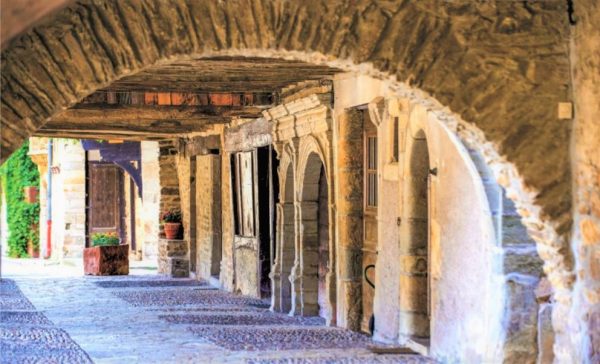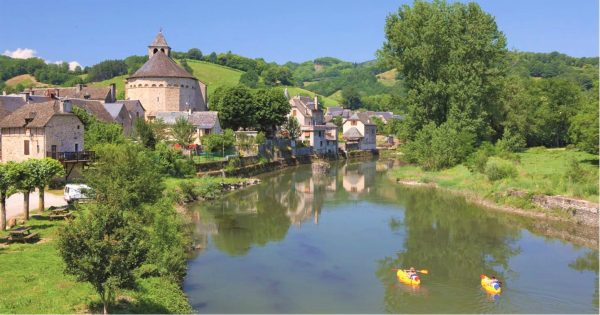On the Plus Beaux Villages trail in Aveyron

When it comes to spectacularly attractive and well-preserved villages, the Aveyron département is truly blessed. It boasts no fewer than ten with the Plus Beaux Villages label – the prestigious guarantee of not merely aesthetic, historical and architectural appeal, but also practical considerations such as accommodation and parking.
A great way to explore all of Aveyron’s rural wonders, perhaps with lunch, dinner or overnight stops along the way, is to plan a visit along its spectacular Route des Plus Beaux Villages. It makes for a very pleasant meander through the region’s famously verdant countryside with many rustic eye-pleasers en route.

Photo © Florian Calais
The bastide town of Najac, which sits atop a rocky ridge high above the Aveyron gorge, is an ideal starting point. Instantly recognisable by its prominent 13th-century castle, it is surrounded by vast woodlands that provide an ever-changing backdrop of seasonal colour palettes. The listed fortress-castle was built during the post-Cathar royal takeover and features a seven-metre keep (the highest in France) from which intrepid visitors are rewarded with spectacular views of the village and Aveyron countryside below.
As you amble along Najac’s lengthy main street, you can feel the history in the stone of medieval houses, the Gothic Saint-Jean l’Évangéliste church (with a hexagonal belfry stuck on the side) and the remarkable 14th-century fountain.

Photo © CDT Averyron. D.Viet – CRT Occitanie
CREATIVE TRADITION
East of Najac is the next Plus Beau Village, Sauveterre-de-Rouergue. Another bastide that charms you back into the Middle Ages, it spanned out from the main central square as the village grew, thanks to tax breaks offered by the King. This led to artisans, including forgers, cutlery makers, hat makers, drapers and butchers, setting up shop – their arcades and store fronts remain today, and add to the step-back-in-time experience.

Photo © CDT Averyron. D.Viet – CRT Occitanie

Photo © CDT Averyron. D.Viet – CRT Occitanie
Sauveterre’s creative traditions are still upheld too, thanks to the opening of an arts and crafts centre in the former convent and presbytery, as well as the presence of Max Capdebarthes’s high- quality leather goods shop. Due north, via the regional capital of Rodez, is the stunning village of Belcastel, a former stopover for Saint-Jacques-de-Compostelle pilgrims that sits in a hollow beside the Aveyron river. It features a spectacular castle – first begun in the 9th century and restored in the 1970s by architect Fernand Pouillon – that appears to be cradled by a clutch of quaint stone houses.
Step inside to see a fine collection of armour as well as art exhibitions. In June 2019, a sculpture by Crystal Wagner will be installed around the façade of the château, transforming the exterior into a hybrid of historical architecture and colourful abstract forms. Down by the river on sunny days, there is nothing more enjoyable than a picnic in the shade of the old medieval bridge or a stroll along the riverbank.
Heading from Belcastel to the northern tip of the département, you reach a much-admired gem in the Aveyron crown, and another Saint-Jacques pilgrim stop-off: Conques. Nestled in a lush setting near the Dourdou River, the village seems to have come straight out of the Middle Ages, its cobbled streets and half-timbered houses topped with stone roofs.
The epitome of tranquillity, it really is a wonderful place for an olde-worlde wander. Conques’s main focal point and visitor draw is its mesmerising abbey-church, dedicated to Sainte-Foy – a golden, bejewelled depiction of whom is located in one of the treasure rooms inside.

The Abbey Church. Photo © CDT Averyron. D.Viet – CRT Occitanie
In addition to its incredible tympanum – now viewable in ‘colour’ at night courtesy of a marvellous light show – depicting 124 characters (count them!) facing Last Judgment, the abbey-church also pulls off a rare trick. It blends Romanesque architecture with modern art, thanks to stained-glass windows created by Aveyron’s most famous artistic son, Pierre Soulages (a visit to the museum dedicated to his life and work in Rodez is a must).
RIVERSIDE ATTRACTIONS
Estaing is next as we travel to north-east Aveyron. Another picture of riverside cuteness in the lush fold of the Lot valley, it has a château at its heart; one classified as a historical monument in 1945 and purchased in 2005 by former French President, Valéry Giscard d’Estaing. It was built in the 13th century around a pentagonal keep – and visitors today can enjoy a guided tour of the tower.
In the village, admire the beautiful façades dating from the 16th, 17th and 18th centuries, the Hôtel Cayron (now the town hall), the church that houses the relics of Saint-Fleuret and the Maison de la Vigne honouring local wine production. Still in the Lot valley, head to Saint-Côme-d’Olt, a circular village whose ancient ramparts now serve as walls for many of its houses. Three ancient portes (gateways) give access to the medieval village centre with its huddle of homes and twisted alleyways full of intrigue and calm. What sets Saint-Côme-d’Olt apart from other villages is its church, complete with striking, ‘twisted’ bell tower.

Saint-Côme-d’Olt. Photo © CDT Averyron. D.Viet – CRT Occitanie
Built in a flamboyant Gothic style between 1522 and 1532, its beautifully carved oak doors share an architect, Antoine Salvanh, with the magnificent bell tower of Rodez Cathedral. Each door is decorated with 365 hammered wrought-iron nails dating from 1532.
Also not to be missed are the castle of Castelnau, which dates from the 13th century and is now the town hall, and the Chapel of the Penitents.
Further east, downstream along the River Lot, is Saint-Eulalie- d’Olt. In addition to its many architectural charms (11th-century church, 15th-century castle, Renaissance hôtel particulier) it also has an eye for the arts (a museum dedicated to artist Marcel Boudou) and a gloriously floral attitude to decorating its public spaces. Head to the village on the second Sunday in July to witness a dressed-up procession by local residents, as they honour what are said to be fragments of Christ’s crown of thorns held in the church.
TIMELESS BEAUTY

Pyre by the River Tarn. Photo © T. Lambelin – Tourisme Averyon, Fahpa, CDT Averyon
Down in the south-east of Aveyron we find Peyre, 7km from Millau in the shadow of the mighty viaduct. Sitting by the River Tarn – where a spot of gentle kayaking and other outdoorsy activities are in order – Peyre’s unique selling point is its stunning troglodytic houses.
The Romanesque church, which was fortified in the 17th century, is worth a detour too. Visitor attractions include the Maison de la Truffe, which showcases all that the terrific, locally abundant tuber has to offer.

Photo © T. Lambelin – Tourisme Averyon, Fahpa, CDT Averyon
Located in the Causse de Larzac plateau, the village of La Couvertoirade first appears in the form of two towers rising in the distance. As you approach and enter its ancient gates, you are immersed in a huddle of twisted streets, small covered passages and 15th-century houses.
Elsewhere, the lovely old windmill on Rédounel hill is the only restored one in the Aveyron, while the village’s original 14thcentury oven, long abandoned, has been restored and put back into operation, serving up traditional local breads for visitors to buy. Far from being merely a living museum, La Couvertoirade is also kept lively by plenty of artisan shops.
The last village on our circular tour is Brousse-le-Château. Perched on a rocky spur and built in the 9th century at the confluence of the Tarn and Alrance rivers, its titular castle has retained its five impressively sturdy defensive towers.
The castle and village benefited from preservation programmes begun in the 1960s and today the church, oratory, characterful houses and Romanesque bridge make Brousse-le-Château an exceptional site. It is a worthy and proud recipient of the Plus Beaux Villages label and the perfect place to conclude a tour of Aveyron’s finest nooks.

Saint-Eulalie-d’Olt. Photo © T. Lambelin – Tourisme Averyon, Fahpa, CDT Averyon
AVEYRON ESSENTIALS: WHERE TO STAY AND EAT
Hôtel ** Restaurant L’Oustal del Barry +33 (0)5 65 29 74 32 12270 Najac www.oustaldelbarry.com
Hôtel Restaurant du Vieux Pont *** Restaurant 1* Michelin +33 (0)5 65 64 52 29 12390 Belcastel www.restaurant-belcastel.comHôtel ****
Le Sénéchal Restaurant 1* Michelin +33 (0)5 65 71 29 00 12800 Sauveterre-de-Rouergue www.hotel-senechal.fr#
Hôtel **** Restaurant Ste-Foy +33 (0)5 65 69 84 03 12320 Conques www.hotelsaintefoy.com
Hôtel Restaurant Le Moulin d’Alexandre ** +33 (0)5 65 47 45 85 12130 Sainte-Eulalie-d’Olt www.aumoulindalexandre.fr
Château de la Falque Centre Balnéo *** +33 (0)5 65 62 45 60 12130 Saint-Geniez-d’Olt www.chateau-la-falque.fr
Auberge Saint Fleuret ** +33 (0)5 65 44 01 44 12190 Estaing www.auberge-st-fl euret.com
Chambres d’hôtes Les Mourguettes +33 (0)6 11 08 35 30 12230 La Couvertoirade www.mourguettes.com
Hôtel Restaurant Le Relays du Chasteau Logis de France ** +33 (0)5 65 99 40 15 12480 Brousse-le-Château www.le-relays-du-chasteau.com
Hôtel **** Domaine de Cambelong Restaurant 1* Michelin +33 (0)5 65 72 84 77 12320 Conques www.moulindecambelong.com
B&B Manoir de la Fabrègues et Spa +33 (0)5 65 66 37 78 12190 Estaing www.manoirattitude.com
Domaine de Gaillac Restaurant – Musée +33 (0)5 65 62 26 85 12230 Sauclières www.arnalgaillac.com
Château de Creissels **** +33 (0)5 65 60 16 59 12100 Creissels (nr Peyre) www.chateau-de-creissels.com
Hôtellerie du Couvent de Malet ** +33 (0)5 65 51 03 20 12500 Saint-Côme-d’Olt hotel-malet-aveyron.fr
Share to: Facebook Twitter LinkedIn Email
More in artisinal, Castle, historical, medieval, rural, village
Leave a reply
Your email address will not be published. Required fields are marked *



